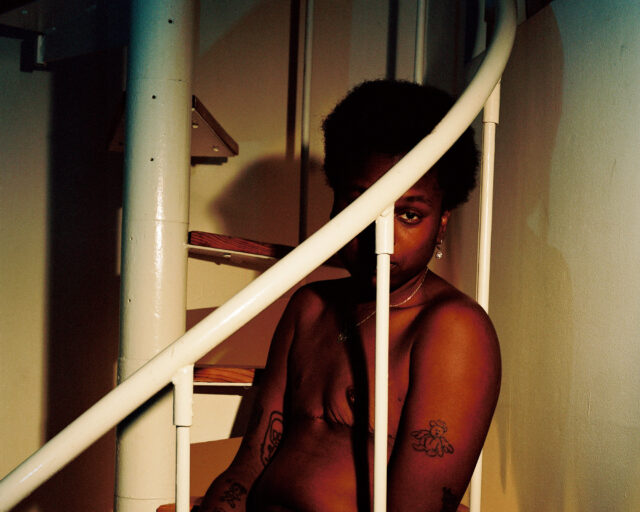The Archipelago of Desire
In Cape Verde, a Portuguese photographer documents the trans community with candid intimacy.

Pauliana Valente Pimentel, Quel Pedra, 2016
Courtesy the artist and Museu Coleção Berardo, Lisbon
On the remote island of São Vicente, in the archipelagos of Cape Verde off the coast of West Africa, there is a rock referred to as Quel Pedra, or “that stone.” According to a local legend, anyone who sits on the stone instantly becomes gay. Such legends have lead to the discrimination against individuals who don’t conform to heteronormative gender roles, but on São Vicente a more inclusive perspective has developed.
When the Portuguese artist Pauliana Valente Pimentel traveled to São Vicente in 2014 as an artist-in-residence for the Cape Verde International Photo Festival, she was inspired by photographs of the island’s first gay pride parade the previous year. Once on the island, she befriended a group of young gay men and trans women, ages seventeen to twenty-five, and began to document their lives. In Quel Pedra (2016), her new series featured in the Novo Banco Photo prize exhibition at the Museu Coleção Berardo in Lisbon, Valente Pimentel portrays a distinctive community with insight and intimacy. When I visited the exhibition recently, which included the work of her fellow prize nominees Félix Mula and Mónica de Miranda, I was struck by Valente Pimentel’s candid view of young people experimenting with gender and sexuality.

Pauliana Valente Pimentel, Quel Pedra, 2016
Courtesy the artist and Museu Coleção Berardo, Lisbon
For over a decade, Valente Pimentel has immersed herself in the lives of others as a way to explore relationships, especially those between adolescents. Thinking about today’s global economic and migration crises, Valente Pimentel explained to me recently, she has been particularly attracted to the earnest nature and mutability of young people. (Her interest in fluid identities extends from previous work documenting transsexual prostitutes her hometown of Lisbon.) In Mindelo, the capital of Quel Pedra, Valente Pimentel was surprised to find members of the LGBTQ community living with the support of their families and friends.
Unlike the neighboring islands and mainland countries, São Vicente has developed an unusual acceptance of non-binary gender identities and sexualities. (In Santiago, Cape Verde’s capital, intolerance toward the LGBTQ community persists, despite the legalization of same-sex sexual conduct in 2004; same-sex marriage is still not recognized). During her time on the island, Valente Pimentel observed the hybrid influences of both European and African cultures within the city’s small population, which might account for an environment in which individuals have more latitude to define their identities on their own terms.

Pauliana Valente Pimentel, Quel Pedra, 2016
Courtesy the artist and Museu Coleção Berardo, Lisbon
The spirit of hybridization saturates Valente Pimentel’s untitled photographs from São Vicente of Steffy and her seven friends Edinha, Gi, Elton, Sindji, Suzy Marie, Henio, and Jason. In one image, we see Suzy Marie wearing a leopard-print jumpsuit and mint, snake print heels; on a rocky hillside, she sits atop a rusting oil barrel, in front of her small, shed-like house. Her gaze is one of calm confidence, and her muscular body rests comfortably in a pose that exudes feminine strength and dignity. Through experimenting with fashions and poses, Valente Pimentel’s subjects consider ways to perform identities such as “sexy,” “feminine,” “tough,” or “masculine.” In another photograph, Suzy Marie wears a white bra with pulled-down straps and blue boxer briefs that read “MEN” on the waistband. Behind her hangs a garment bursting with pink and white feathers, pink satin, and jewels. The soft, light pose, luxurious textures and tones imitate the casual opulence of classical painting and sculpture. In this way, Valente Pimentel’s investigation of identity pays tribute to luminaries of queer and feminist theory such as Simone de Beauvoir, who famously wrote, “One is not born, but rather becomes, a woman.”
For her video Catwalk (2014), Valente Pimentel filmed an improvised runway show put on by the eight friends. They chose a former Portuguese fort called Fortim d’El-Rei (King’s Fort) as their stage, effectively contrasting the island’s militaristic and capitalist colonial history with its creative and sympathetic—though economically depressed—present. The unrehearsed film’s use of slow motion renders dreamlike choreography, alluding to the act of living between reality and fantasy. Taken together with the photographs, Valente Pimentel’s project captures a community that embraces the confident blurring of gender binaries. Unencumbered by the supposed obligation to be either a singular thing or its opposite, Steffy, Edinha, Gi, Elton, Sindji, Suzy Marie, Henio, and Jason each demonstrate the innumerable ways of being human.
Novo Banco Photo 2016 is on view at the Museu Coleção Berardo, Lisbon, through October 10, 2016.

























